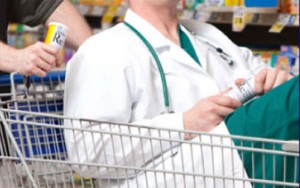 The Pain Source Your source for pain medicine news and information on neuromusculoskeletal conditions, interventional pain procedures, orthopedic test videos, and journal article reviews
The Pain Source Your source for pain medicine news and information on neuromusculoskeletal conditions, interventional pain procedures, orthopedic test videos, and journal article reviews Categorized | Definitions in Pain, Miscellaneous
Definitions Related to the Use of Opioids in Pain Medicine
Posted on 15 September 2011.
By Chris Faubel, M.D. -
Listed below: Addiction, Pseudoaddiction, Opioid-induced hyperalgesia, Tolerance, Pseudotolerance, Physical dependence, Diversion, Doctor-shopping

Source: blog.drfirst.com
Addiction
- A biopsychosocial process that results in compulsive and harmful useof opioids.
- Characterized by continued use of the narcotics despite harm to self, cravings, and compulsive/impaired use of the meds. The "harm" can be physical, mental, or social.
- Examples:
- A patient is prescribed OxyContin 40mg one pill every 12 hours for his chronic low back pain. Instead of taking it as prescribed, the patient will have cravings for the medication pain relief (and high), such that he takes it every 4 hours until he runs out, and then goes and steals money to buy more off the street.
- Or, this same patient is taking so much Roxicodone that he can not stay awake. His boss at work informs him that his lethargy and tardiness is not acceptable and that further behavior like this will result in his termination of employment. The patient continues this Roxicodone use "despite harm" and loses his job.
- Patient crushes the opioid, dissolves it in water, and injects it to get that rapid euphoria. [impaired use]
- Isolation from family and friends because of the intense focus on "scoring" and aberrantly-taking more narcotics.
Pseudoaddiction
- Term used to describe patients that have some of the same actions as seen in addiction, but this time it's because the patient's pain is truly undertreated.
- Patients will become obsessed with watching the clock (til their next scheduled dose), and may even doctor shop to obtain enough medication to adequately treat their pain.
- May even use illicit drugs to reach the needed pain relief.
- This can be distinguished from true addiction, by the fact that the above actions stop when the patient's pain is effectively treated.
Opioid-induced Hyperalgesia
- Paradoxical increase in atypical pain that is unrelated to the original painful stimulus — occurs after prolonged opioid use
- Increased sensitivity to pain.
- Will see worsening of the hyperalgesia if you increase the dosage of the current opioid. [as opposed to a reduction in pain if the patient developed tolerance]
Tolerance
- A physiologic state of adaptation in which the use of an opioid medication induces changes that result in diminished drug effects over time.
A need for increasing opioid dosages over time to maintain the same level of pain relief; and this need can NOT be explained by disease progression.
- With opioids, it could be their analgesic effect, or even the adverse drug effects such as sedation, nausea, or dizziness. Patients rarely develop a tolerance to the constipation effect of opioids.
- Proposed mechanisms: (1) Opioid receptor desensitization; (2) Receptor down-regulation
Pseudotolerance
- A falsely diminished effect of opioids that is NOT due to a physiologic process.
- This perceived decreased benefit from the opioid dose is a result of:
- Increased physical activity by the patient
- New/progressed pathology (i.e. increased nerve root compression)
- Lack of compliance with the dosing schedule (patient not taking the medication as frequently or regularly as prescribed)
- Change in medication formulation (many patients have noted this with the newest OxyContin formulation)
Physical Dependence
- A normal biological effect that results in withdrawal signs and symptoms when the opioid is suddenly stopped, the dose is rapidly reduced, or an opioid antagonist is given to the patient.
- This will happen to anyone that has used opioids consistently.
- Also seen with many other drug classes, such as corticosteroids, antidepressants, alcohol, benzodiazepines, and beta blockers.
- NOT associated with an addiction disorder
- Patients may fear these withdrawal effects so much that they continue to express the need for the opioids despite resolution of their actual pain. This does not necessarily mean the patient is "addicted"; if the weaning of the medication is done slowly enough, and with supportive medications to handle any adverse effects, the patient will be able to tolerate the process and not fear life without their opiates.
Diversion
- A patient intentional giving or selling their medication to others.
- For example: A patient getting their monthly script filled for Opana ER and IR, keeping enough for themselves so they pass their urine and blood screening (or enough to handle their true pain), and selling the rest for monetary gain.
- This can be possibly thwarted by calling the patient into the office for random pill counts throughout the year (between office visits). A patient can always try to find a dealer to sell or loan them enough meds to have a normal pill count, but this would still be a way to minimize this diversion activity.
Doctor-shopping
- A patient receiving controlled medications from multiple physicians unbeknownst to each doctor.
- For example: A patient establishes a doctor-patient relationship with multiple doctors to get his low back pain treated with prescriptions of Percocet. Now that patient has multiple providers writing for controlled medications that he then gets filled at different pharmacies around the state.
- Prescription drug monitoring programs (PDMP) have been great at exposing these individuals. After logging in to the states monitoring system online, patient information (such as name, SSN, date of birth) is put into the computer, and a list of controlled prescriptions that were filled at every pharmacy in the state is displayed (along with the physician's name that prescribed them). This allows a physician to see if his/her patient is receiving the same or similar opioids from multiple providers. Unfortunately, not all states have a system like this. Click here for a list of states with a PDMP.


